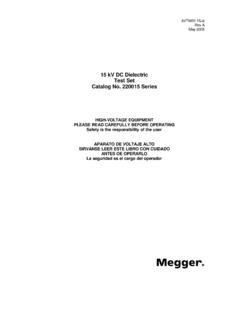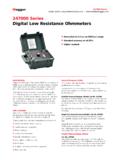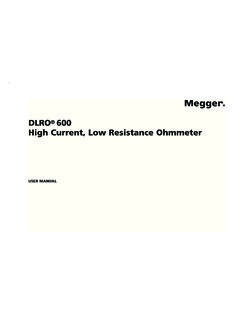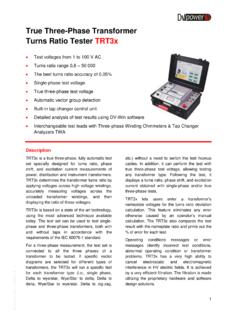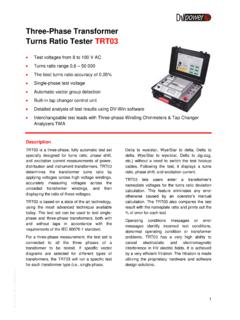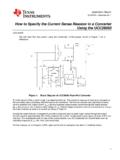Transcription of SALVAGING FLOOD DAMAGED ELECTRICAL …
1 SALVAGING FLOOD DAMAGED ELECTRICAL equipment Overview In all drying out of ELECTRICAL windings, the regulation of temperature should be controlled carefully. Maximum drying temperatures on windings should not exceed 194oF (90oC) as measured by thermometer. This will prevent not only the rapid thermal deterioration of the insulation but damage from the high vapor pressures that would be obtained if steam were produced. Several methods are available for drying equipment . Probably the most satisfactory solution to the problem is when the windings can be placed in an oven with suitable temperature control and proper air circulation. Banks of infrared lamps may be used when this is not possible, or a suitable housing may be built around the machine, using steam coils or electric resistance type units for a source of heat. Openings should be provided for the free circulation of air.
2 Blowers may be used to increase the air movement. Vacuum drying has also been effectively used to expedite the return of equipment to service. Certain precautions are necessary if this method is used, and it should be carried out only by experienced personnel. Another method often used is to circulate low-voltage current through the windings. This should not be done, however, until the insulation resistance has reached a value of at least 100,000 ohms. Look for Megger Insulation Testers that have kilohm ranges in order to perform this check prior to application of current. These models include the BMM Series and MIT320 & 330. Measurement is performed at only 5 V, so will not damage even the worst of insulation. Welding sets may be used to provide the current. The flow should be limited to only a fraction of nameplate amperes, and a careful check must be maintained on maximum temperatures on the insulated parts.
3 On ac generators, drying current may be provided by driving the units at less than rated speed with the terminals short-circuited and excited with very low values of field current. Here again, this should be done only by those with experience in such methods. During drying operations, when insulation resistance values are used as an indicator of the suitability of windings for service or for application of test potential, the drying must be continued for a sufficient time to make sure that the values are reliable. Often the resistance curve will take one or more sharp dips before leveling off or continuing to increase in a positive direction. This is due to moisture working out of the windings. When the machine is completely dried out, further work is required to remove any remaining dust. This may be done through the use of dry compressed air at pressure not exceeding 40 psi.
4 With respect to particular classes of ELECTRICAL equipment DAMAGED by flooding, the procedures listed below should be followed. Rotating ELECTRICAL Machines 1. Completely dismantle all parts. 2. To remove silt or dirt, wash all parts of the machine except ball or roller bearings, but including windings with clean, fresh water or stem clean them. Follow this AVO International Page #2 SALVAGING FLOOD DAMAGED equipment with a thorough cleaning, using a suitable grease solvent. Many such cleaners are toxic, and the necessary safety precautions should be taken. 3. Thoroughly clean all bearings and housings, paying particular attention to oil grooves and oil reservoirs, which may collect silt and dirt. Disconnect and swab any oil lines, or stem clean and dry them. 4. Dismantle brush rigging and clean insulators. Some insulators will retain water, and must be dried thoroughly.
5 5. Do not apply any voltage to a winding until an insulation resistance reading of at least 100,000 ohms is obtained for several hours, and then only a very low voltage should be used. If windings are very wet, even the low voltage of hand-cranked ohmmeters can puncture the insulation. To avoid this, the crank should be turned at low speeds until some knowledge of insulation resistance value is obtained. Modern microelectronic testers have voltage regulation that eliminates this problem. As mentioned above, models with kilohm ranges at low voltage (BMM Series and MIT320 & 330) are ideal. The motor can first be checked at low voltage to be assured that it meets the 100-kohm requirement, and then the effectiveness of the drying process can be monitored until resistance has increased into the megohm range. 6. Commutators can be difficult to dry out.
6 It may be necessary to loosen or even remove some of the V-ring bolts or clamping nuts in order to let the water out from the inside of the commutator. On large commutators it may be necessary to increase the drying temperature to as high as 266oF (130oC) if lower temperatures do not produce satisfactory results after a reasonable period. 7. Bands on armatures or rotors should be checked carefully for tightness. For some applications, they will have to be replaced because of looseness resulting from drying out of insulation underneath. 8. Some slot wedge materials will be affected by moisture. All wedges should be carefully examined and new wedges installed where necessary. 9. DC motor or generator field coils and field coils from synchronous machines sometimes present problems. It may be necessary to remove these coils from the machines for proper treatment if it is found that it is impossible to bring up the insulation resistance otherwise.
7 After a thorough drying in a suitable oven, they should be immersed completely in insulating varnish while hot, and allowed to cool while still immersed. This will tend to draw the varnish into the inside layers. When cooled, the coils should be checked for short circuits by making a comparative test of their resistance. A Megger DLRO10 digital low resistance ohmmeter will indicate open coils, and can also be used to determine shorted turns by the reduction in resistance that turn-to-turn shorts produce. 10. After a thorough cleaning and drying, most windings should be treated with insulating varnish, particularly if cleaning solvents have removed any of the varnish coatings. Dipping and baking-type varnish, followed by a suitable baking period, is preferable, but air-drying varnish may be used to expedite the return of equipment to AVO International Page #3 SALVAGING FLOOD DAMAGED equipment service; this latter type is only recommended if the original varnish is in reasonably good condition.
8 11. Before any machine is started, check the entire installation, paying particular attention to lubrication and ELECTRICAL connections. Determine that no tools or materials have been left in or on the machine. Three-phase motors being restored to service can have proper connection assured for correct rotation with the Biddle Motor and Phase Rotation Tester (560060). This model will check correct phase rotation for both motor and live line, while 3-phase lines can be separately checked with a Phase Sequence Indicator (565250). When put back into service, rotational speed of motors can be readily checked with the family of Biddle Contact and Photoelectric Hand Tachometers (359985, 359986, 359987). These handy instruments are particularly useful as flooding may have made digital on-line indicators inoperative. For routine ELECTRICAL checks, remember that Megger offers a full line of hand-held and clamp-on multimeters.
9 Switchboards and ELECTRICAL Controls 1. Thoroughly clean and dry out all control equipment , dismantling where necessary. Operating coils should be thoroughly dried and dipped in insulating varnish and baked or given one or more coats of air-drying insulating varnish. Check all contacts. Be sure moving parts operate freely. 2. Oil pans on starters and oil switches must be cleaned, dried out, and refilled with oil of proper dielectric strength. Insulating oil can be tested in full conformance to ASTM standards with the Megger OTS60PB and OTS60SX Oil Test Sets. Insulating barriers should be dried out or replaced if badly warped. 3. Meters and relays usually will have to be reconditioned at either the manufacturer's service shop or factory. In many instances, it will be cheaper to replace them. 4. All bus insulators and control wiring on switchboards should be cleaned and dried thoroughly.
10 Normally, an insulation resistance of at least one megohm per 1,000 volts operating potential, with a minimum of one megohm, should be obtained before energizing. This is a very basic and universal insulation requirement, and can be performed with any Megger Insulation Tester. Specific models should be further evaluated for additional features and functions against additional demands and operator s preferences, as well as budget constraints. Standby batteries should be checked for their readiness to come on line using the BITE family of Battery Impedance Testers (BITE2, 2P, & 3). Battery straps can be checked for corrosion or excessive resistance with the DLRO10. Transformers 1. Remove covers or inspection cover plates. Note the condition of the oil and windings, and check for signs of failure. Many transformers are oil insulated, and flooding may have introduced contaminants, including water, that will reduce dielectric strength and deteriorate performance.

